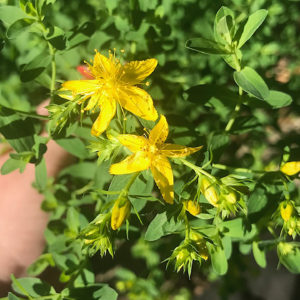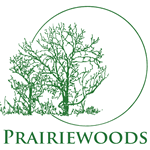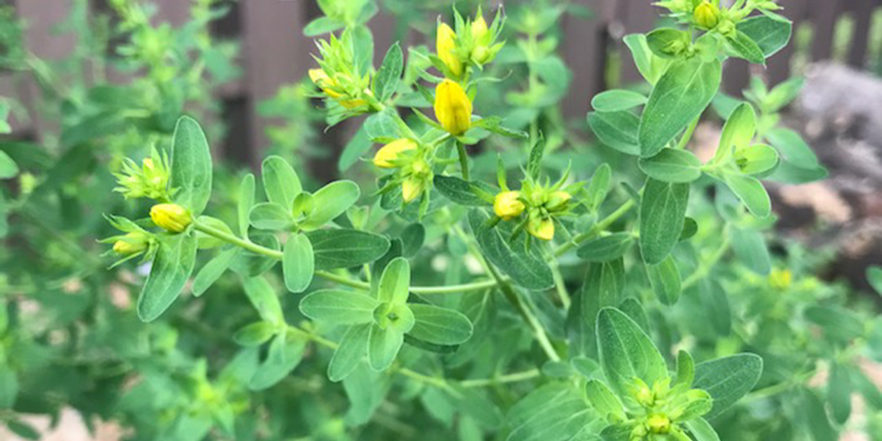“St. John’s Wort is one of the so-called St. John’s herbs—which also include yarrow, mugwort, fennel, and elder; they would be picked on St. John’s birthday and hung over doors and windows to keep evil spirits away.”
—Caz Hildebrand, Herbarium (2016)
If ever there was a time when we needed help in keeping evil spirits away, surely this is it.
I planted several shrubs of Hypericum perforatum late last summer. They were on clearance from a garden center, and I brought them home. Maybe, just maybe, I hoped, they would survive.
They did more than survive; they are now thriving in my herb garden.
 Most people are familiar with St. John’s Wort as a supplement that may help with depression. This certainly is one traditional use of the plant. However, this perennial also has demonstrated anti-inflammatory, antimicrobial and astringent effects, and clinical trials have shown the application of an oil infused with St. John’s Wort to be beneficial in healing wounds. Especially those wounds that have been long-lasting and slow to heal on their own.
Most people are familiar with St. John’s Wort as a supplement that may help with depression. This certainly is one traditional use of the plant. However, this perennial also has demonstrated anti-inflammatory, antimicrobial and astringent effects, and clinical trials have shown the application of an oil infused with St. John’s Wort to be beneficial in healing wounds. Especially those wounds that have been long-lasting and slow to heal on their own.
Hypercum perforatum is commonly called St. John’s Wort because it offers its first blooms around the June 24th feast day of St. John the Baptist. This year, my shrubs offered their first full blooms on June 14th. I was delighted to see the tiny, delicate flowers when I went for my morning garden walk. In my herbal practice, I’ve had to rely upon dried material ordered from organic suppliers. This is quite fine for healing purposes, but I’m excited by the process of working with the St. John’s Wort that I have planted, tended and harvested myself.
In the present moment, when we are struggling to survive a pandemic; when it seems we have reached a point at which white Americans can no longer ignore the depth of racism that pervades our society and its structures; when the global climate crisis brings new challenges every day; it seems that maybe we need the healing lessons of St. John’s Wort more than ever.
Perhaps we can take the delight we find in beautiful things, such as the first blooms of the summer, and use it to craft a joy and a resilience that can sustain us through not only dark times but also the hard work that must be done. Healing is not a passive process. Truly effective healing requires a lot of invisible, unheralded labor. Often we talk about the importance of rest and retreat as a way to promote healing. In doing so, we forget that there is a lot of work going on in our cells and tissues and souls while we outwardly rest. There is something amiss in the way we celebrate when a wound or injury has been healed, rather than celebrating the process along the way.
This, I think, is what St. John’s Wort is calling on us to do this summer: to do the work of healing. Our community’s COVID threat will not simply disappear. Our nation’s race relations will not heal themselves. Our planet’s climate crisis will not correct itself (and if it does, we may not like the outcome!). So many of our usual activities are no longer available to us. Perhaps as we “rest” from them, we can use this time and this energy to heal that which desperately needs healing in our selves, our communities, our nation and our world.
Plants can heal us. Forests can bathe us in their phytochemicals. They cannot address systemic racism, prevent the spread of a life-threatening virus or reverse climate change. These are our burdens, our tasks, our work to do. We have many wonderful allies to support us, including St. John’s Wort. The work, though, is ours.
—Caroyln Herbst Lewis, Prairiewoods program facilitator


